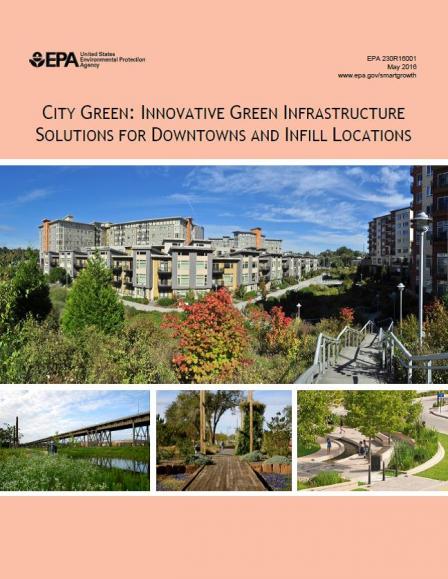 Communities of all sizes and in all climates are using green infrastructure to manage stormwater where it falls using the natural processes associated with soils and vegetation to capture, slow down, and filter runoff, often allowing it to recharge ground water. Green infrastructure manages stormwater to control flooding from small storms and improve water quality and offers a wide range of other environmental, economic, public health, and social benefits.
Communities of all sizes and in all climates are using green infrastructure to manage stormwater where it falls using the natural processes associated with soils and vegetation to capture, slow down, and filter runoff, often allowing it to recharge ground water. Green infrastructure manages stormwater to control flooding from small storms and improve water quality and offers a wide range of other environmental, economic, public health, and social benefits.
City Green: Innovative Green Infrastructure Solutions for Downtowns and Infill Locations (2016) is for local governments, private developers, and other stakeholders who help shape redevelopment projects in downtowns and infill locations where development has already occurred. It provides inspiration and helps identify successful strategies and lessons learned for overcoming common barriers to using green infrastructure in these contexts. The examples could encourage cities to adopt policies that would expand the number of projects incorporating similar green infrastructure approaches.
Twelve case studies showcase projects from around the country that have overcome many common challenges to green infrastructure at sites surrounded by existing development and infrastructure. In these cases, space is at a premium, and soil conditions are often unknown or unsuitable for infiltration. The case studies help identify successful strategies and lessons learned for overcoming common problems. The case studies are:
- The Waltham Watch Factory, Waltham, Massachusetts.
- Queens Botanical Garden, Flushing, New York.
- The Kensington Creative and Performing Arts High School, Philadelphia, Pennsylvania.
- The Radian Complex, Philadelphia, Pennsylvania.
- The Sand River Headwaters Green Infrastructure Project, Aiken, South Carolina.
- The Menomonee Valley Industrial Center, Milwaukee, Wisconsin.
- The Uptown Normal Circle, Normal, Illinois.
- The Metro Green Line, St. Paul, Minnesota.
- Stapleton Greenway Park, Denver, Colorado.
- Santa Fe Railyard Park and Plaza, Santa Fe, New Mexico.
- Mint Plaza, San Francisco, California.
- Thornton Creek Water Quality Channel, Seattle, Washington.
Though green infrastructure can be more challenging to implement in redevelopment projects compared to projects in undeveloped areas, the barriers are usually surmountable. These case studies help counter real and perceived obstacles to using green infrastructure in downtowns and infill locations by providing successful examples showing that:
- Careful site planning and selection of practices allow green infrastructure to work on contaminated sites and sites with poor soils.
- Historic properties can incorporate context-sensitive green infrastructure compatible with the historic fabric.
- Green infrastructure fits into highly space-constrained sites.
- Municipalities are removing regulatory obstacles to allow green infrastructure projects.
- Green infrastructure can provide effective stormwater management in arid climates and areas where water rights are a concern.
- Green infrastructure can be a cost-effective approach to stormwater management and can help drive economic development.
- Long-term maintenance can be addressed by thoughtful upfront planning and innovative approaches.
Find more resources on:
You may need a PDF reader to view some of the files on this page. See EPA’s About PDF page to learn more.- City Green: Innovative Green Infrastructure Solutions for Downtowns and Infill Locations (PDF)(75 pp, 9 MB, 2016, 230-R-16-001)
